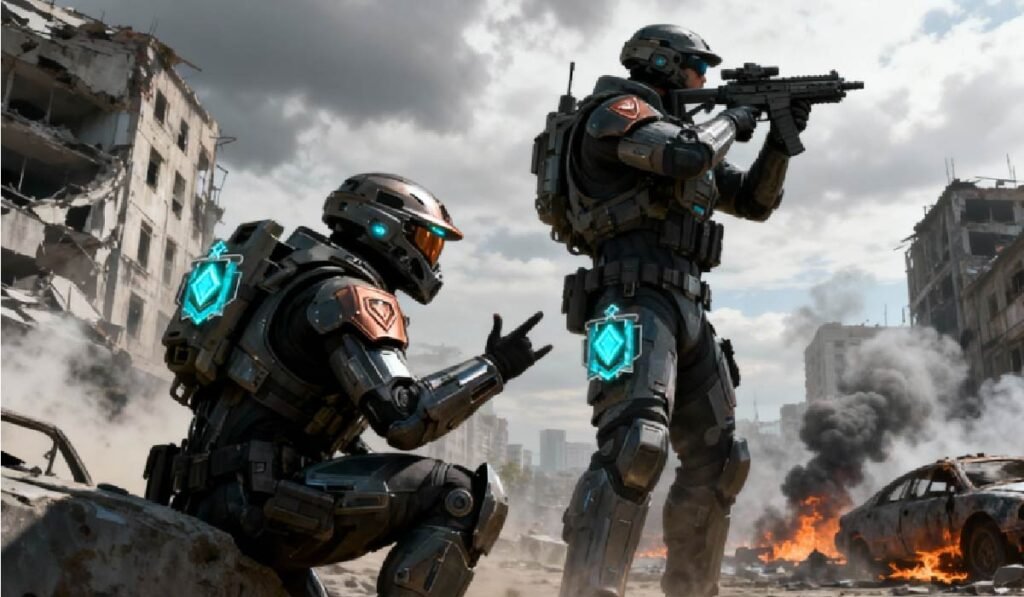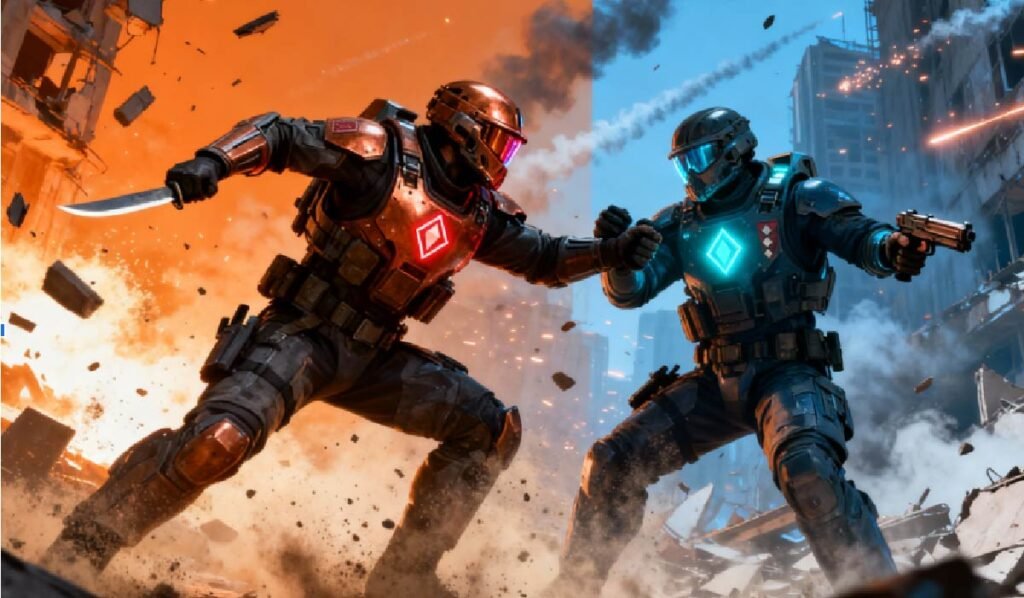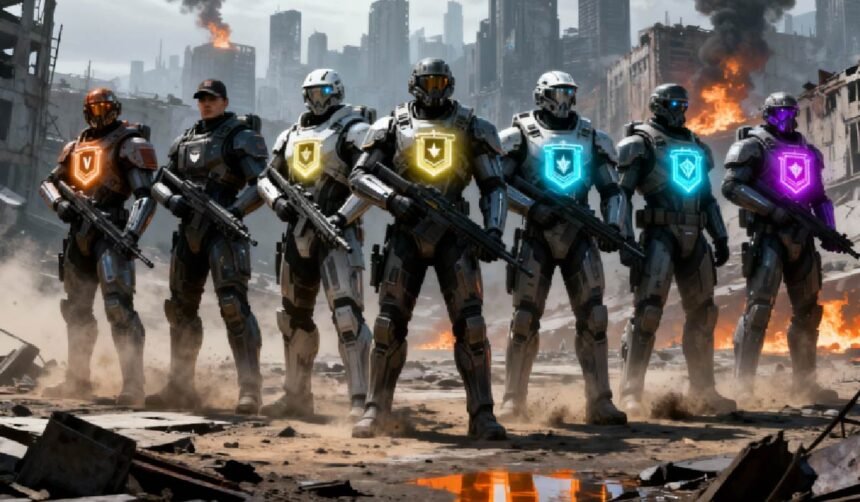If you’ve ever wondered why you’re matched with people who seem both way worse and way better than you, or how Ranked 2.0 turned the ladder into a Rubik’s cube, this is your roadmap. We’ll break down how the new system really ticks and how to climb it without losing your sanity.
And if your mental health ever starts drafting a surrender letter, remember there’s always Rainbow Six Siege rank boosting, the express elevator to higher lobbies, fewer headaches, and far less sweat.
What the Rainbow Six Siege Ranking System Actually Measures
Since Operation Solar Raid (December 2022), Siege runs on Ranked 2.0, a system that splits your visible progress from your hidden performance score.
- Visible rank: what you see on your profile – Copper through Champion. It shows how far you’ve advanced this season.
- MMR (Matchmaking Rating): a hidden number Ubisoft uses to build balanced matches. It reflects your true skill and doesn’t reset each season.
Every new season, your visible rank resets to Copper V, but your MMR quietly influences who you meet. That’s why a Copper lobby can still feel suspiciously sweaty.
All Rainbow Six Siege Ranks in Order
There are eight main tiers, and most have five sub-divisions (V to I). Only Champions stands alone at the top.
| Tier | Sub-Ranks | RP Range (approx.) |
| Copper | V – I | 100 – 500 |
| Bronze | V – I | 500 – 1 000 |
| Silver | V – I | 1 000 – 1 500 |
| Gold | V – I | 1 500 – 2 000 |
| Platinum | V – I | 2 000 – 2 500 |
| Emerald | V – I | 2 500 – 3 000 |
| Diamond | V – I | 3 000 – 5 000 |
| Champions | – | 5 000 + |
Each win grants Rank Points (RP). The exact amount depends on your performance and MMR difference between teams. Lose, and you drop RP accordingly.
According to Ubisoft’s latest season data, less than 1 percent of players reach Champions. The vast majority sit between Silver III and Gold II. So if that’s you, you’re in statistically solid company.
Who Can Play Together in Ranked
Ranked 2.0 removed the old restrictions that prevented certain ranks from teaming. Now, anyone can squad up.
The catch: the game uses the highest MMR in the party to seed matchmaking. So if your friend is secretly a Diamond and you’re climbing out of Bronze, brace for pain. You’ll meet tougher opponents – balanced to that higher hidden rating.
Cross-play exists between consoles and separately between PC + cloud platforms, but never across those groups. If you’re trying to queue with friends on another ecosystem, check Ubisoft’s official cross-play chart before raging at the invite button.
How the System Works Behind the Curtain
Every match updates two things:
- MMR – the invisible skill rating Ubisoft tracks from your overall play history.
- RP – the visible rank points for seasonal progression.
MMR looks at:
- Wins and losses (weighted by opponent skill)
- Personal impact (kills, objective play, assists)
- Consistency over many matches
Because MMR doesn’t reset, your “true” matchmaking level stays roughly stable even after a season reset. The system just makes you re-earn the visible rank to prove current form.
Each season lasts about three months, after which ranks reset and rewards drop based on the highest division you reached.
Rewards: Why the Grind Feels Worth It
At season’s end, Ubisoft hands out cosmetics for every division you cleared. That includes charms, weapon skins, Alpha Packs, and card backgrounds.
Progressing steadily is usually better than sprinting late in the season: rewards stack per division passed. Climb from Silver V to Platinum II? You’ll collect everything along that path.
How To Unlock Ranked Mode
New players must reach Level 50 in Casual or Quick Match first. That’s roughly 30 to 40 hours of normal play – long enough to learn maps, recoil patterns, and gadget basics.
Once unlocked:
- Open the main menu.
- Select Ranked from the playlist.
- Queue up, and prepare for tactical chaos.
Ubisoft added this gate for good reason: early griefing dropped dramatically when under-leveled accounts were kept out.

How To Climb the R6 Ladder Faster
There’s no magic exploit – only better habits. But they stack up fast when practiced deliberately.
1. Communicate Like a Pro (Not a Drill Sergeant)
Voice comms are the difference between a lucky win and a clean sweep. Use concise callouts (“Two on yellow stairs,” “Rotate through freezer”).
Don’t flame teammates. Siege rewards information, not ego. A calm mic wins rounds. If you lack a stable voice solution, low-latency apps like GameTree’s integrated voice chat or Discord VC channels can help.
2. Learn Maps Like You’re Studying for Finals
Aim helps, but map knowledge is the real power stat in Siege. Knowing camera angles, breach spots, and rotation paths beats raw reflexes.
Start with smaller pools – Clubhouse, Oregon, Consulate – and watch pro-player replays to see how they anchor or attack sites. Ubisoft’s official Situations mode is a surprisingly good solo lab.
3. Play the Operator, Not the Ego
Every Operator has a clear role: entry, intel, support, denial. Use your gadgets first, gun second.
A good Dokkaebi or Lion can swing rounds without firing a shot. You’ll climb faster by mastering a flexible trio of mains for different team comps rather than locking the same Operator every round.
4. Build a Duo or Squad
Solo queue is a dice roll. Two coordinated players can shift momentum instantly.
If you don’t have regular teammates, use LFG platforms like GameTree or Ubisoft’s official Squad Finder to meet players with similar goals and temperaments. Matching playstyle and comms rhythm matters as much as rank.
5. Take Breaks on Losing Streaks
Siege tilts hard. When frustration sets in, accuracy and decision-making nosedive. After two or three losses, queue out. Walk, stretch, hydrate, reset.
Coming back fresh saves both MMR and sanity.

Common Misconceptions About R6 Ranks
- “Visible rank equals skill.” Not quite. It reflects recent streaks more than total ability.
- “MMR reset each season.” False. Only your visible rank resets; your hidden MMR persists.
- “You can’t play with lower ranks.” Outdated – Ranked 2.0 removed that cap.
- “Kills define rank gains.” Partial truth. Objective play and win rate weigh heavier.
Knowing these distinctions keeps expectations realistic and makes progress feel less random.
Why Ranked 2.0 Feels Fairer (Mostly)
Before 2023, the old MMR ladder often produced wild matchups and deranking exploits. Ranked 2.0 fixed much of that by decoupling visible rank from skill rating and by averaging team MMR rather than using only the highest player.
Ubisoft’s telemetry reports show significantly tighter win-rate bands – most matches now land near 50 percent odds. It’s not perfect, but statistically, it’s a truer test of coordination and map knowledge than before.
Final Thought
Rainbow Six Siege still rewards brains over reflexes. The new ranking system didn’t just reshuffle badges – it emphasized what Siege has always been about: precision, planning, and mutual trust.
So, load up, stay calm, and remember: even the best Champions started as nervous Coppers who learned to check corners twice.







